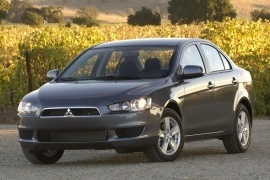
MITSUBISHI Lancer
Generations Timeline, Specs and Pictures

After almost a decade since its first appearance on the market, the Lancer received a final facelift before it was completely changed in 2017.
When Mitsubishi introduced the Lancer in 2007, nobody thought that the carmaker would keep it into production for such a long time. But the struggling Japanese carmaker couldn’t afford to change it. Its finances were hit hard during the world financial crisis, and its products were already old and difficult to sell. The Lancer was supposed to save the brand, but it just couldn’t do it by itself.
For 2016, the Mitsubishi designers reshaped the front bumper and made it bigger, and included the LED daytime running lights on the outer side-pods. Unlike many other carmakers, they didn’t install LED headlights since they were too expensive to implement. On its sides, the Lancer featured a new set of side-skirts.
Inside, the carmaker kept the same spartan look of the interior, but it installed an updated touchscreen infotainment system on top of the center stack. The binocular-style instrument cluster remained the same as before, with a TFT display between the tachometer and speedometer. For the sedan version, the Lancer featured a fixed, split-folding rear bench seatback.
Under the hood, the base version featured a naturally aspirated 2.0-liter engine that provided 148 hp. The other engine option was a 2.4-liter naturally aspirated unit that provided 20 ponies more. Both versions were paired as standard to a 5-speed manual while a CVT was on the options list.

Unveiled in 2007 at the Detroit Motor Show, the seventh generation of the Mitsubishi Lancer marked the first generation that was named Lancer all over the world.
The seventh generation of the Lancer was available in two body versions: three-box sedan and hatchback. Most of its fame came from the rally world, where the Lancer, along with the Subaru Impreza, were the last two cars that could meet the highest specifications of a Group N rally configuration. Apart from the hi-spec Lancer Evolution, the regular Lancer was available with other smaller, economical, engines.
The exterior look was fresh, with a big, trapezoidal, grille on the front and two angular headlights. The grille was extended into the front bumper. The angular shapes were extended on the bodywork up to the taillights. Depending on the engine and trim level, there were standard 16” steel wheels or 18” light-alloy wheels.
Inside, the dashboard was clean with two-round clusters on the dashboard. Depending on the option, an infotainment system with Bluetooth connectivity, a navigation system, and a USB aux was available. The firm, slim, front seats ensured good side support. The flat rear bench was good for two adults, but the transmission tunnel was obstructing the third passenger.
The Lancer was available with various engines starting with a 110 hp 1.5-liter naturally aspirated engine. Another 1.8-liter was available. Since the European customers asked for diesel engines, Mitsubishi installed a VW-supplied 2.0-liter TDI unit.

The new Lancer Ralliart from Mitsubishi was first introduced at the 2008 Paris Motor Show along with its Sportback Ralliart brother and represents a more affordable version of the Lancer Evolution X model.
The car boasts distinctive exterior features like exclusive air scoops on the bonnet, exclusive alloy wheels and a small rear diffuser. It features a de-tuned Evo X turbocharged 2.0-liter MIVEC petrol engine, which produces 240 hp and 253 ft-lb. of torque. Like the Lancer Evolution X it features Mitsubishi’s full-time 4WD and comes exclusively with the Japanese maker’s SST 6-speed twin-clutch transmission.

The seventh generation Mitsubishi Lancer received a major facelift in 2003 that targeted mostly its appearance.
The car’s front and rear ends were restyled to further differentiate the car from its performance Evolution counterpart while other changes occurred as well depending on which market the car was sold on. The choice of engines was broadened over what the sixth generation had to offer, with a choice of SOHC and DOHC plants ranging in displacement from 1.3 L to 2.4 L, the later having been available with Mitsubishi’s signature MIVEC electronic valve-timing control system.

Mitsubishi introduced the sixth generation of the Lancer in 2000, and, besides the ferocious, rally-inspired Evo VI, it also produced a more civilized four-door sedan.
It was the last Lancer based on the same platform with the Mirage. But it had almost no technical connection with the Lancer Evolution, which was built on a different platform. Still, the name was known, and after all, it was a decent sedan that had plenty to offer for a regular family.
The exterior was not Mitsubishi’s strongest point, although the big, squared, horizontal headlights looked better and offered more light than on the previous generation. A slightly ascending hood and paved the way to the greenhouse. The carmaker installed a set of taillights that looked too small for the car’s size in the back.
Inside, Mitsubishi was not very concerned about high-quality materials and the best finishes in its class. That said, the plastics were of poor quality, and the carmaker left some room for improvement in the fittings department. It offered adequate room for three adults in the back and good for the front ones on the plus side. Depending on the engine and trim level, the Lancer offered power-windows and locks, air-conditioning, and ABS.
Under the hood, Mitsubishi installed only two engines with different settings, ranged between 90 hp and 130 hp. For selected markets, it paired them with an automatic (CVT) transmission and all-wheel-drive.

In 1994, Mitsubishi introduced a sedan version for the Mirage lineup and named it Lancer for specific markets.
Every successful story has a beginning, and the modest-looking Lancer was the base for the future rally-racer named Lancer Evolution. In fact, the 1994 Lancer offered a version named GSR, which was punchy enough to stir emotions in a parking lot among a few car enthusiasts, but not too much to attract more people.
The car’s look was, somehow, bland. Its rounded shapes from the bio-design era were not very clear, like if the design team was not very sure that they had to do that. At the front, the narrow headlights and grille were on the same page with other Japanese carmakers such as the Honda Civic or the Toyota Corolla. The low beltline and tall greenhouse, related to the overall height, was more conventional, like a 1990 Escort.
Inside, the Lancer featured a simple cloth upholstery, but like most Japanese cars from that era, it came well equipped. The power windows and locks and the AC were fitted as standard. In the instrument panel, Mitsubishi installed a center speedometer flanked on the left by the tachometer and on the right by the fuel and coolant temperature gauges, stacked one on top of the other.
Under the hood, apart from the GSR version, the regular Lancer provided similar engines as its Mirage sibling. The base version featured a 1.3-liter engine, while the top version had a 1.8-liter, fuel-injected engine.

The lancer is arguably one of Mitsubishi’s most popular models, having been sold in over 6 million units worldwide since the model’s 1973 inception.
A reliable car with many aliases, the Lancer was known and sold under numerous name tags, such as Colt Lancer, Eagle Summit, Mitsubishi Carisma and Mirage to name only a few. 1988 saw the introduction of the fourth generation Lancer, a more stream-lined car than the previously released ones, powered by a range of engines comprised of two petrol units with displacements of 1.3 L and 1.5 L and a larger 1.8 Diesel plant.























































